10 Composting Facts – Statistics and Data in 2025
-

- Last updated:
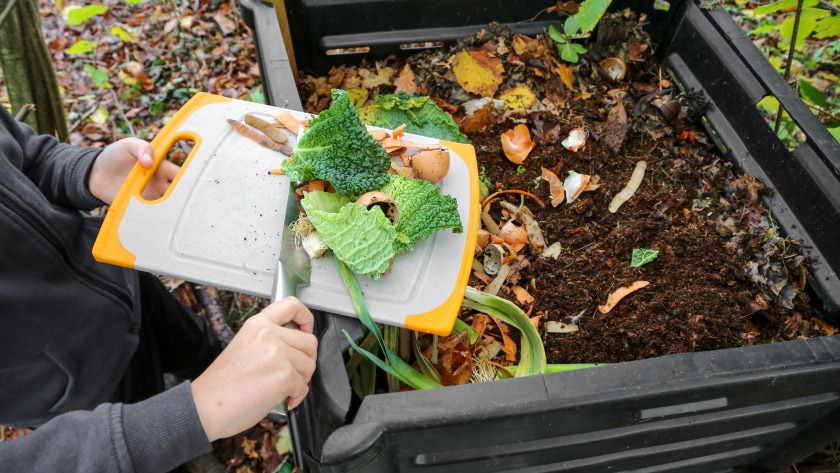
Note: This article’s statistics come from third-party sources and do not represent the opinions of this website.
Composting is an excellent way to recycle your food scraps and turn them into a usable soil additive for your garden. It cuts down on the waste that would otherwise go into a landfill, but there are many sides to composting. In this article, we’ll discuss 10 facts and statistics about composting. That way, you’ll learn more about composting benefits and consider adding composting to your list of home duties.
Click below to jump ahead:
- Benefits of Composting
- The Country With Most Compost and Benefactors of Compost
- Compost Produced and Energy Impact
Top 10 Composting Facts and Statistics
- The application of compost minimizes loss of soil by 86%.
- New businesses in the US can sustain 18 full-time jobs by utilizing 10,000 tons of compost every year.
- By 2024, the compost market is anticipated to reach an estimated $9.2 billion. It’ll have a compound annual growth rate (CAGR) of 6.8% between 2019 and 2024.
- Every year, about 800 tons of compost is purchased by landscapers.
- In the US, only 4.1% of food waste is composted annually. That translates to 2.6 million tons of food.
- South Korea composts more than any other country globally.
- There are around 185 composting facilities in the US. Most of them are privately owned.
- There has been a 65% increase in composting programs worldwide in the last five years.
- Every day, the average American generates 4.4 pounds of waste, but only about 1.5 pounds is composted.
- If eight households in the US composted food scraps, it would offset an average household’s electricity use annually.
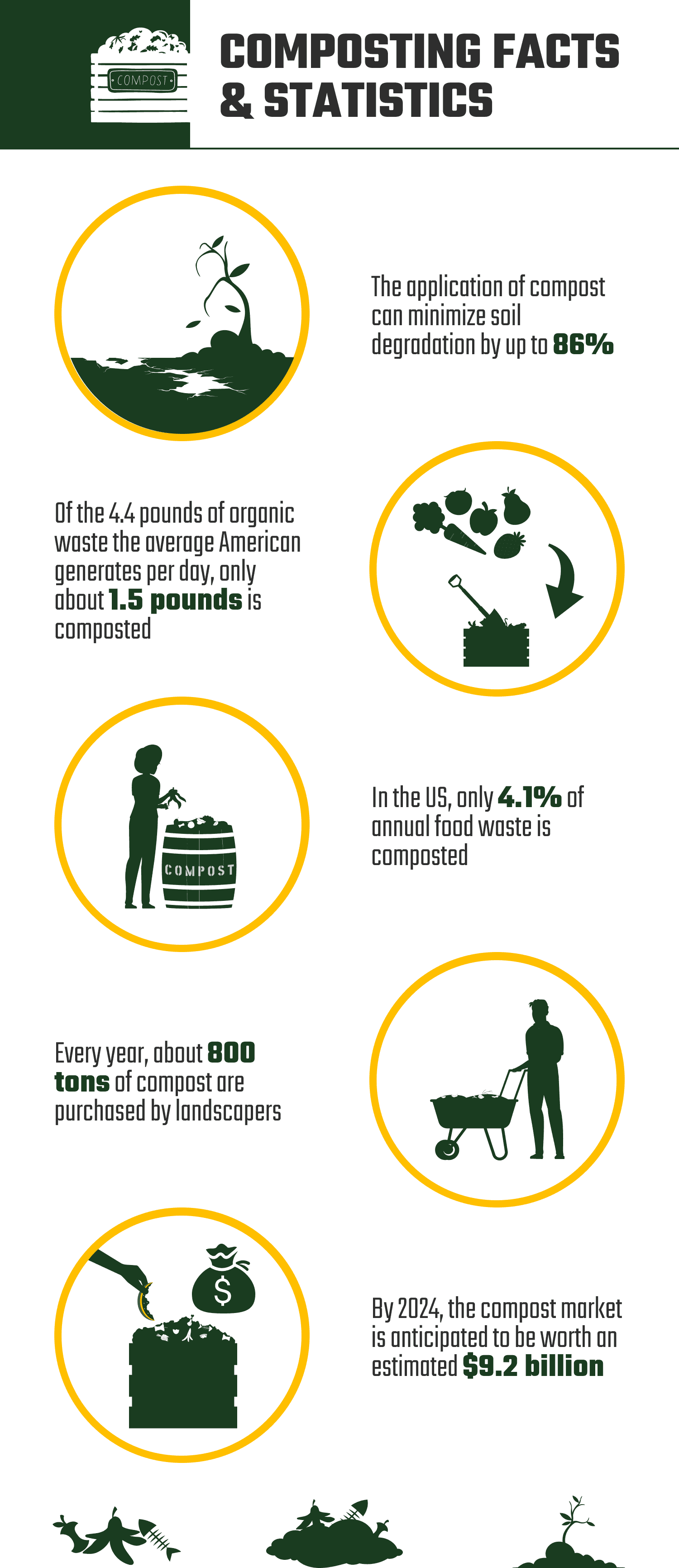
Benefits of Composting
1. The application of compost minimizes loss of soil by 86%.
(U.S. PIRG)
One of the best ways you can improve the structure of your garden soil is to add organic matter, such as compost. It is one of the easiest ways to supercharge your soil and make it healthier. Soil that contains 15% organic matter has a crumbly texture. It can hold up better against the elements than soil without organic matter.
It also has a higher water-holding capacity. Less water runs off your land during rainstorms and snowmelt, which results in less soil erosion. Compost also adds essential nutrients plants need and retains moisture.
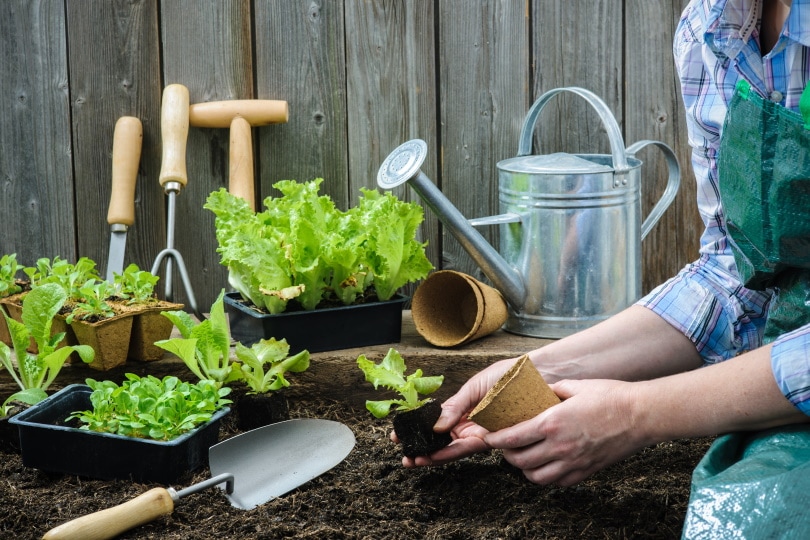
2. New businesses in the US can sustain 18 full-time jobs by utilizing 10,000 tons of compost every year.
(BIOCYCLE)
Compost businesses are popping up throughout the country, even in communities without composters. Besides saving landfills, this practice reduces transportation costs because you can process the materials locally.
Compost can be sold to local farmers to use in growing organic produce. Composting allows businesses to use compost to divert 10,000 tons of carbon while creating jobs and generating revenue. These composting programs save the city money and help businesses cut down on waste removal services, water, and utility bills.
3. By 2024, the compost market is anticipated to reach an estimated $9.2 billion. It’ll have a compound annual growth rate (CAGR) of 6.8% between 2019 and 2024.
(PR NEWSWIRE)
Composting is turning out to be one of the sustainable methods for waste management. The compost market is expected to experience massive growth over the next few years, hitting $9.2 billion by 2024.
It’s due to the industry’s expansion into new markets, rising demand for eco-friendly products, and the growing population. Besides, the rise in the per capita income levels has contributed to the growth of the compost market.
The increasing number of community recycling centers and the growing industrial applications of compost are other factors expected to boost the growth of the compost market.
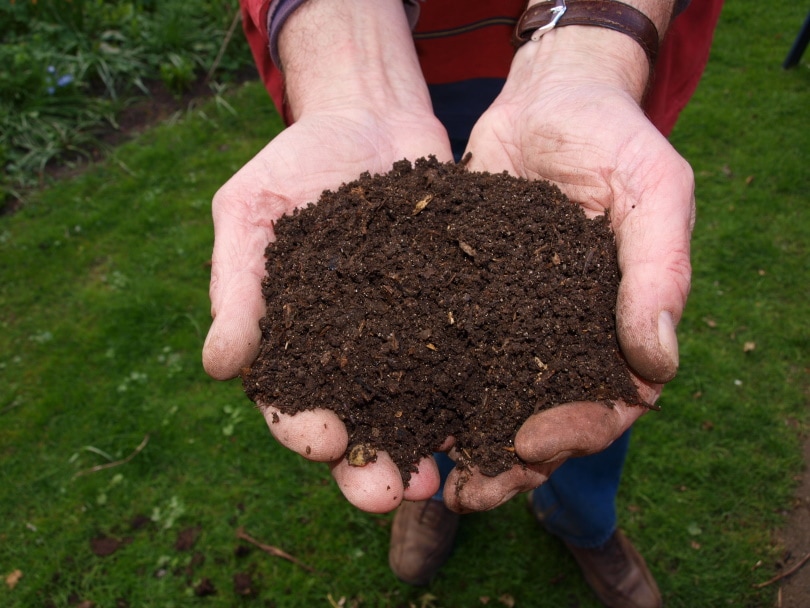
The Country with Most Compost and Benefactors of Compost
4. Every year, about 800 tons of compost is purchased by landscapers.
(ILSR)
Compost is a natural fertilizer that contains nutrients that help plants grow. It is made of animal and vegetable waste such as manure, straw, leaves, and food scraps.
You can buy compost from most nurseries or home and garden stores. Landscapers buy more compost than anyone else because their work revolves around beautifying gardens. You can use compost in potting mixes for potted plants, as well as in garden beds. It also adds essential nutrients to sandy soil.
5. In the US, only 4.1% of food waste is composted annually. That translates to 2.6 million tons of food.
(EPA)
Most of the wasted food in the US is thrown away in landfills. Only a tiny percentage (4.1%) is composted. That’s a massive problem because organic material in landfills decomposes and releases methane into the atmosphere.
Methane is a greenhouse gas that’s 72 times more potent than carbon dioxide (CO2). Organic material in landfills is a massive waste of resources and a major contributor to greenhouse gas emissions and climate change.

6. South Korea composts more than any other country globally.
(WE FORUM)
South Korea is leading the way when it comes to the production and consumption of organic waste. Not only are they the number one producer of organic waste in the world, but they are also a leader in recycling and composting it.
The country produces 13,000 tons of food waste every day. It composts 30% of it. 60% is used to produce animal feed, while 10% generates biofuel. South Korea diverts most of its food waste from landfills and incinerators.
7. There are around 185 composting facilities in the US. Most of them are privately owned.
(BIOCYCLE)
Composting has become a mandatory part of many municipalities’ waste disposal systems in the US. This has led to the development of over 185 composting facilities across most states in the US, and as more people learn about the importance of composting and the process behind it, more facilities are popping up across the country.
Today, it is a popular practice throughout the US because it uses yard and garden debris that would otherwise be thrown away.
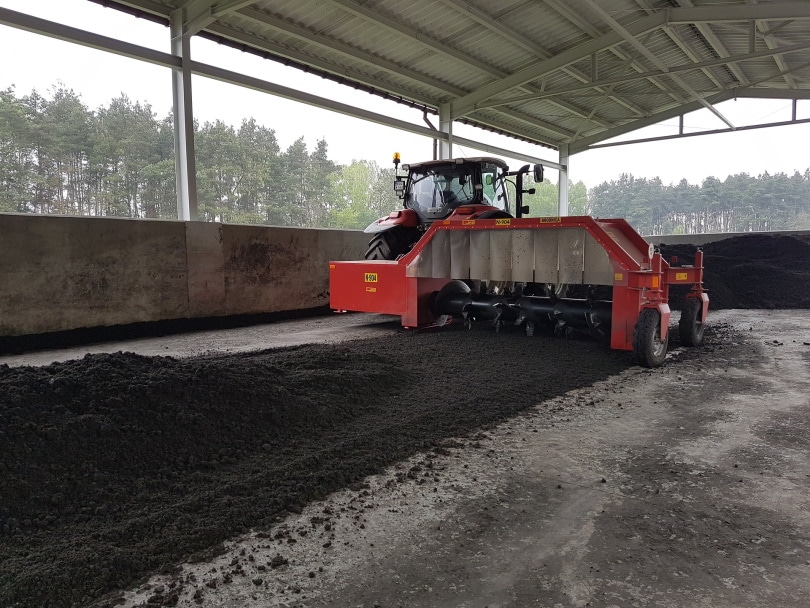
Compost Produced and Energy Impact
8. There’s a 65% increase in composting programs worldwide in the last five years.
(FRONTIER GROUP)
Composting is one of the best ways to reduce your carbon footprint, especially in an urban environment. That’s why many organizations are developing programs to educate people on the subject.
There’s been a notable increase in the number of composting programs globally, and more people realize the importance of composting their organic waste.
The increased interest in composting is made possible by new technologies that reduce odor and speed up composting time. These innovations have allowed compost to be used as a valuable fertilizer for agriculture.
9. Every day, the average American generates 4.4 pounds of waste but only about 1.5 pounds is composted.
(CNBC)
Composting is not only a great way to reduce your waste stream, but it can also be a healthy addition to your garden. However, although Americans produce a lot of waste, only a tiny part of it is composted.
Efforts are being made to compost more waste material to reduce the carbon footprint on the environment.

10. If eight households in the US composted food scraps, it would offset an average household’s electricity use annually.
(WCEE)
Composting is a great way to reduce a household’s environmental impact and make fertilizer. It can also compensate for an average household’s electricity use every year. It is one way that homeowners can be more energy efficient.
Apart from energy compensation, other composting benefits include protecting watersheds and improving soil health by recycling nutrients back into the ground for added nutrients and water retention.
Frequently Asked Questions
What are the disadvantages of composting?
One of the drawbacks of composting is the odor emanating from it. It can be unpleasant if not managed well. Good compost smells like fresh earth, while bad compost smells like rotting garbage or urine.
Compost takes time because it involves processes that break down organic waste into a usable soil amendment called humus. The most basic composting is not a fast process, which is one of the most significant drawbacks of the process.
You must also keep the compost away from the house/garden because it can be messy. Sometimes, it’s difficult to contain the waste in a small area. The compost pile will also attract insects and rodents if you don’t take precautions.
(GREEN COAST)

What are the three types of composting?
Aerobic, anaerobic, and vermicomposting are the three most common types of composting.
Aerobic composting occurs in the presence of oxygen. Compost piles must be turned to allow the oxygen to reach all parts of the compost pile. The decomposition process generates heat, which speeds up the composting process. You can use aerobic compost to grow plants in a garden or any other environment where plants grow on the ground.
Anaerobic composting does not provide enough oxygen to break down organic materials. This type of compost is made from manure and is often called “muck” or “rich muck.” It’s often used as topsoil or in garden beds where growing plants need a lot of organic material.
Vermicomposting uses worms to break down organic materials instead of bacteria. Worms are used because they can survive without oxygen.
(DKMM)
What is the most important variable influencing composting?
The most important variable influencing composting is the ratio of carbon to nitrogen. This ratio determines the amount of carbon in the material being composted compared to the nitrogen amount present.
Besides the carbon-to-nitrogen ratio, several other variables affect the time it takes for a compost pile to break down. They include the moisture content and temperature.
These variables should be just right: not too wet or too dry. Too much water can cause a loss of oxygen, making anaerobic conditions more likely to develop in your compost pile.
(COMPOST TURNER)
What’s the value of composting?
Composting is a natural process used for disposing of biodegradable organic materials. Composting also helps microorganisms grow and aids the decomposition of organic materials.
It involves putting together different organic materials. Biological composting begins when microorganisms break down organic material into smaller pieces.
Using this process, you can put your food remains to good use and avoid unnecessarily filling the landfills.
(UTAH STATE UNIVERSITY)

How does composting help combat global warming?
Composting is a great way to reduce the amount of “greenhouse gases” released into the environment. Emissions from decomposing organic waste are a cause of global warming. But, if you compost, you help prevent this from happening.
The composting process releases carbon dioxide into the atmosphere, but plants absorb it as they grow. Composting may be the method that saves our planet from harmful chemicals and materials that could destroy it.
(COMPOSTING COUNCIL)
How long is the composting procedure?
Composting can take 4 to 6 months for the material to break down, but it depends on several factors. For instance, there are many ways to compost, and each one is different. Depending on what you are composting, the time it takes to break down the material can vary. All composting requires oxygen and heat. The breakdown process will not work without these elements.
Other key factors include the amount of nitrogen and carbon in the compost pile, which can vary depending on what you put into it. The more nitrogen in your compost, the faster it will break down. Generally, green materials have more nitrogen than brown materials, such as twigs or dried leaves.
The moisture content also affects how long your compost takes to break down. Dry material takes longer to decompose than wet material.
(KANSAS HEALTHY YARDS)

What indicates that compost is ready?
Compost is a great way to improve the condition of your garden soil, but you must know when it is ready to use. Compost can take a few months to mature and be ready for use. If the compost has a distinctive earthy smell, it’s ready. You may also notice a mossy or forest floor scent. Compost should not have a foul odor.
The color of the compost is another factor to consider. As the compost continues to mature, it will turn darker in color, from brown to black. This depends on how much time has passed and other factors, such as the amount of green material added to the pile.
It’s also crucial to feel the texture of your compost. When you dig into the pile with a shovel, it should feel dry and crumbly like soil. The texture should not be overly sticky or wet at all. If it feels moist, add more brown material (leaves, shredded paper) to absorb moisture away from the center of your compost pile.
(GREEN ACTION CENTER)
Why is composting crucial?
Compost is made from various organic materials. They include food scraps, leaves, grass clippings, and manure. Once these materials are mixed and allowed to decompose for several months, they’ll be ready for use in your garden or on your plants.
One of the benefits of composting is reduced landfill waste. If you throw trash into the landfill each week, you can reduce the garbage you throw away in one year by composting. This reduction can save you money and reduce greenhouse gas emissions.
Adding composted matter to soil also improves the health of your plants and flowers by providing vital nutrients and retaining water. Plants grown in compost grow stronger roots that can reach deeper into the soil for nutrients. The resulting plants are healthier than those grown without compost.
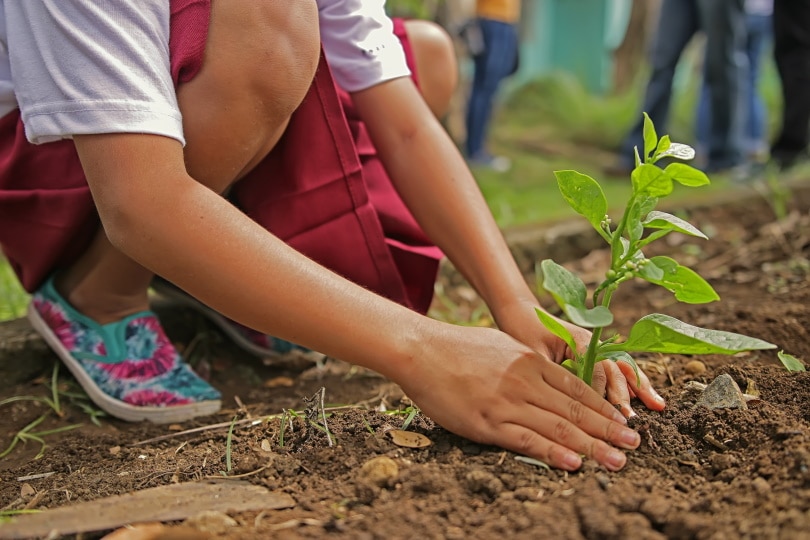
Compost is a free source of fertilizer. You don’t have to buy expensive chemical fertilizers when you can get the exact amount of nutrients your plants need without the risk of over or under-fertilizing.
Composting also saves energy. When you compost, you don’t need to burn fuel to incinerate garbage in a trash incinerator. You also don’t have to send it to a landfill somewhere else to be buried underground. It’s more energy-efficient to turn your organic waste into compost and use it around the yard.
Conclusion
Composting gives you the power to improve the environment and your local community. It’s an easy, inexpensive solution for breaking down organic waste and turning it into something useful. You help reduce landfills, control pests and diseases, and beautify the land. Also, it creates a better ecosystem for all life forms to thrive.
However, it is still a relatively new concept to most people. Sometimes, you might not understand how much of an impact you can have through composting. As more people begin composting, the positive effects will radiate into their communities. These facts and statistics on composting are not only interesting but also compelling. If you want to do your part for the environment, consider composting at home.
Related Reads:
Featured Image Credit: Jerome.Romme, Shutterstock
Contents

